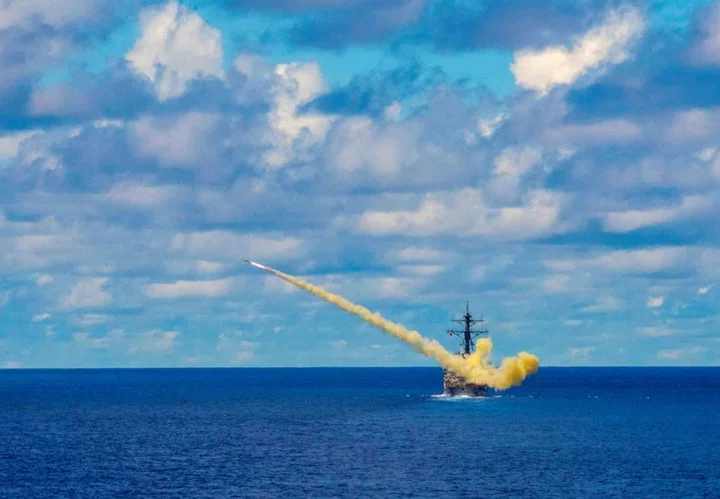By Mike Stone
WASHINGTON (Reuters) -U.S. officials want to tinker with the mix of chemicals fueling missiles and rockets to gain an advantage in the Pacific by increasing the range of its frontline munitions so U.S. forces can operate farther away from China.
The Pentagon and Congress are looking at a retrofit that could extend ranges for some current weapons as much as 20% by using more powerful propellants and lighter warheads, two congressional aides and two U.S. officials said who spoke to Reuters under the condition of anonymity because they were not authorized to speak publicly.
Last week, the Senate revealed bill language earmarking at least $13 million to plan, expand and manufacture chemical compounds that can be used to propel missiles, or replace the explosive material in warheads, known as "energetics".
Although a fraction of the $886 billion defense bill making its way through Congress, the funding starts a process that could ultimately lead to billions of dollars of new spending on munitions.
The Democrat-controlled Senate and Republican-held House of Representatives still need to negotiate final funding levels for the concept, but there is general agreement on the bipartisan effort to deter China.
The "distance in the Indo-Pacific and sheer size of (China's) Navy means the U.S. needs more ship-killing missiles that can reach distant targets," Representative Mike Gallagher told Reuters. China views the U.S. in the Pacific as a threat, ramping up its own military presence in response.
"Unfortunately, the Pentagon has grown complacent using 1940s-era energetics and neglected advanced energetics like CL-20 that are necessary to increasing the range and lethality of our force. Every foot farther a missile can travel is a foot farther an American service member is from danger."
CL-20 PROGRAM
Pending final approval in Congress, the bill would set in motion a Pentagon program to try to add more range to existing weapons using chemicals such as China Lake Compound #20, also known as CL-20, aides and people familiar with the plan told Reuters.
Developed by a government laboratory in California back in the 1980s, CL-20 is one of the most discussed chemical compounds under consideration, one senior defense official said. Congress has gravitated to studies, like one published in 2021, that said repowering a rocket with CL-20 - along with other changes - could extend its range by about 20%.
A paper by the Energetics Technology Center said new energetic materials give a 400-pound bomb "the same lethality as a current 1000-pound bomb," adding China makes "CL-20 on an industrial scale and built it into weapons systems."
Northrop Grumman Corp is one of the main makers of CL-20 in the United States. The other main rocket motor maker is Aerojet Rocketdyne which was purchased last week by L3Harris Technologies.
The Senate earmarked funds would be used to establish an office for energetic materials within the Department of Defense answering to the Deputy Secretary of Defense Kathleen Hicks, according to the legislation.
The office would be a coordinating body across the Army, Navy and Air Force to cut through institutional red tape.
"This relatively modest investment for energetics is a meaningful and important initiative," said Tom Karako, a weapons expert at the Center for Strategic and International Studies.
Karako said the cost of re-powering or using new explosive chemicals in weapons in the U.S. inventory could be in the billions of dollars, adding that the figure was heavily dependent on which weapons were re-powered, and how many were modified or purchased.
Iain Overton, executive director with the nonprofit Action on Armed Violence, said the race to tweak already lethal weapons was not progress.
"History is said to repeat itself, and in the sense that arms races always end badly," he said. "Does bigger, more deadly weapons make us safer? The answer is a resounding: no. In the last decade, when explosive weapons were used in populated areas, 90% of those reported killed or injured globally were civilians."
The House version of the annual defense bill requires the Pentagon to run a CL-20 pilot program that switches out either the explosive or propellant in three existing weapons.
The House version does not name any weapons, but Bob Kavetsky with the Energetics Technology Center said candidates for the new chemicals include the Lockheed Martin-made long range anti-ship missiles and extended range air-to-surface missiles. Other candidates include Harpoon anti-ship missile made by Boeing and Javelin anti-tank weapons made by Lockheed and RTX.
(Reporting by Mike Stone in Washington; Editing by Chris Sanders and Aurora Ellis)

